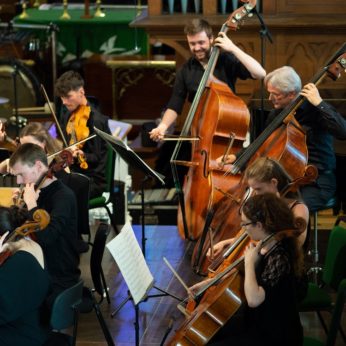Composer: Dmitri Shostakovich (b. 1906 - d. 1975)
Performance date: 04/07/2018
Venue: St. Brendan’s Church
Composition Year: 1964
Duration: 00:26:16
Recording Engineer: Ciaran Cullen, RTÉ
Instrumentation Category:Full/Chamber Orchestra
Artists:
Liana Gourdjia -
[violin]
Yuri Serov -
[piano]

Festival Strings, Leana Gourdjia [leader], Yuri Serov [conductor]
Dmitri Shostakovich [1906-1975]
Symphony for Strings in A flat major Op. 118a [1964]
Transcribed by Rudolf Barschai from String Quartet No.10 with the composer’s approval
Rudolf Barschai founded the strings-only Moscow Chamber Orchestra in 1955. Previously he had been the violist in the very first edition of the Borodin Quartet, when it was known as the Moscow Philharmonic Quartet. So he worked regularly with Shostakovich, who later entrusted him with the premiere of his 14th Symphony. Transcriptions of string quartets are well-known ways to expand the then limited repertoire for string band and for this reason Barschai transcribed Shostakovich’s Third, Fourth, Eighth and Tenth Quartets, the latter being originally dedicated to Weinberg.
Yesterday I completed another quartet. It is dedicated to M.S.Weinberg. He had written ten quartets and had thus overtaken me. I therefore set myself the task of catching up with him, which I have now achieved. However Weinberg won the competition in the end as he wrote seventeen quartets, though we have not yet heard all of them. Barschai’s transcription is true to the original with the addition of basses. The extra strings smooth some of the edges, but add body and power to the outcry of the Allegretto furioso
The Andante that opens this work appears serene and untroubled. The question posed in the first bars is answered peacefully and out of this exchange emerges a consolatory theme of great beauty. The subsequent dialogue of question and answer is occasionally threatened by growls in the bass and there is an outburst sul ponticello from the violas, but the aura of peace is not unduly disturbed, which makes the extraordinary explosion of the Allegro furioso all the more unsettling. The extra strings underline the sheer brutality of this movement, the tramp of boots is made all the more horrific – the power and savagery of this music sweeps all more civilised emotions away.
The Adagio in A minor takes the form of his favourite passacaglia, the solo violin sings a theme of transcendent beauty followed by eight variations. Shostakovich wrote the original quartet at a composer’s retreat in Armenia, near where his first wife, Nina, had worked. She had died from cancer in 1954, but there is much in this movement that speaks of her. The finale follows without a break. This is the longest movement and it carries the weight of the work’s resolution. It opens with a cheerful theme on the violas that leads to an idea akin to an Armenian hurdy-gurdy folk dance. This is then married with the energy of the opening theme, building gradually to a powerful climax, when the passacaglia theme is dramatically recalled. The coda reintroduces the first movement theme closing the circle and the morendo ending is witty and almost cheerful, dispelling the darkness of the second movement.
Francis Humphrys
Copyright © 2024 West Cork Music. All rights reserved.
Designed and developed by Matrix Internet